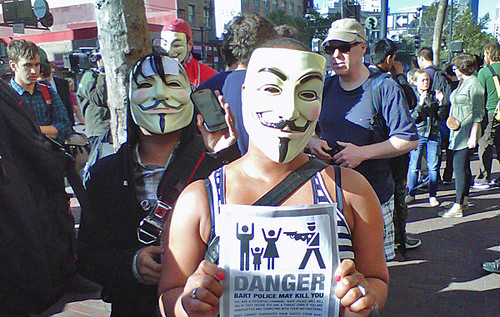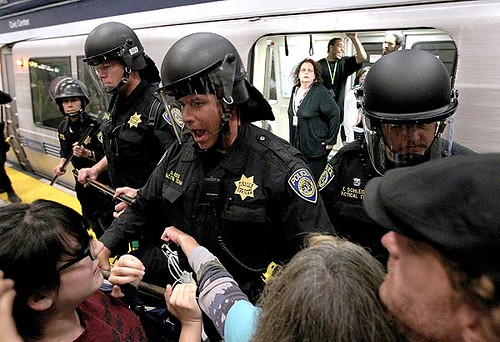Cyber organizing and urban/transportation system vulnerability
 Image: A BART worker, left, tries to move demonstrators away from a train so it can leave the Civic Center station -- one of four downtown San Francisco stations closed during rush hour Monday by protests. (Justin Sullivan, Getty Images / August 16, 2011).
Image: A BART worker, left, tries to move demonstrators away from a train so it can leave the Civic Center station -- one of four downtown San Francisco stations closed during rush hour Monday by protests. (Justin Sullivan, Getty Images / August 16, 2011).
Yesterday, a number of BART stations closed in response to their being targeted as part of a demonstration against alleged brutality by BART transit police and a previous decision to turn off cellular service within the transit system to reduce the likelihood of protest. See "Protest closes 4 BART stations, leaving commuter crowd stranded: Downtown San Francisco train stations and a swath of busy Market Street close as followers of the 'hacktivist' group Anonymous protest alleged police brutality."
Note that while I might not like it much, the conservative "Tea Party" movement is in fact, organizing, and it hasn't been fully captured by the power structure, as the author asserts.
From the article:
This is largely because although movements carry anger, anger doesn’t make a movement — organizers do. Anger helps, of course; it’s a resource that organizers can stoke, channel and exploit.
Although saints and psychopaths will take great risks in the service of their beliefs, most people are a little more calculating. People protest when they believe that something is wrong, that it could be otherwise, and that their efforts are both necessary and potentially effective.
They rarely make these calculations by themselves. Rather, they respond to those around them. Ostensibly spontaneous eruptions of political protest reflect the hard work and investment of organizers who cultivate grass-roots activism. Organizers point to a government’s provocations, focusing on the issues that they believe will spur action. They nurse both moral righteousness and a sense that it’s actually possible to get something done — both essential for sustained action. And, perhaps most important, they point to others who are already active, telling the newly recruited that they are not alone and that, together, they can matter.
We just don't like/are afraid of the results.
And generally, we, and by "we" I mean progressives, aren't doing a very good job articulating why what we care about matters, and why, and positioning and massaging the message so that it reaches people where they are amenable to listening.
There are a bunch of books I am planning to read on social movements (these articles from the Stanford Business School Magazine are about some of the work I intend to read, "Professor Sarah Soule Explains Effective Social Movements" and "How Markets Are Made and Broken by Social Activists"), and frankly, the work I am doing in "bicycle facilities systems integration" is a form of organizing, but that is for a later post.
In the meantime, these are particularly powerful pieces relevant to organizing and social movements, even if one piece is ostensibly only about open systems software coding.
-- Building Public Will
-- The Cathedral and the Bazaar

Masked protesters at the Civic Center station. Maria La Ganga, Los Angeles Times.

Bay Area Rapid Transit police push back demonstrators who are trying to keep a train from leaving the Civic Center station in San Francisco. (Justin Sullivan / Getty Images / August 15, 2011)

Commuters wait outside the Montgomery Street station. It was closed for about two hours Monday night, along with a busy swatch of Market Street. Maria La Ganga, Los Angeles Times.
Labels: participatory democracy and empowered participation, progressive urban political agenda, protest and advocacy, provision of public services



0 Comments:
Post a Comment
<< Home